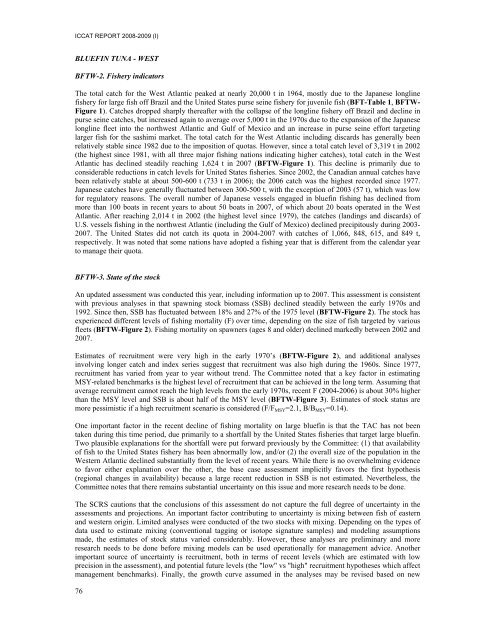REPORT OF THE STANDING COMMITTEE ON RESEARCH ... - Iccat
REPORT OF THE STANDING COMMITTEE ON RESEARCH ... - Iccat
REPORT OF THE STANDING COMMITTEE ON RESEARCH ... - Iccat
Create successful ePaper yourself
Turn your PDF publications into a flip-book with our unique Google optimized e-Paper software.
ICCAT <strong>REPORT</strong> 2008-2009 (I)BLUEFIN TUNA - WESTBFTW-2. Fishery indicatorsThe total catch for the West Atlantic peaked at nearly 20,000 t in 1964, mostly due to the Japanese longlinefishery for large fish off Brazil and the United States purse seine fishery for juvenile fish (BFT-Table 1, BFTW-Figure 1). Catches dropped sharply thereafter with the collapse of the longline fishery off Brazil and decline inpurse seine catches, but increased again to average over 5,000 t in the 1970s due to the expansion of the Japaneselongline fleet into the northwest Atlantic and Gulf of Mexico and an increase in purse seine effort targetinglarger fish for the sashimi market. The total catch for the West Atlantic including discards has generally beenrelatively stable since 1982 due to the imposition of quotas. However, since a total catch level of 3,319 t in 2002(the highest since 1981, with all three major fishing nations indicating higher catches), total catch in the WestAtlantic has declined steadily reaching 1,624 t in 2007 (BFTW-Figure 1). This decline is primarily due toconsiderable reductions in catch levels for United States fisheries. Since 2002, the Canadian annual catches havebeen relatively stable at about 500-600 t (733 t in 2006); the 2006 catch was the highest recorded since 1977.Japanese catches have generally fluctuated between 300-500 t, with the exception of 2003 (57 t), which was lowfor regulatory reasons. The overall number of Japanese vessels engaged in bluefin fishing has declined frommore than 100 boats in recent years to about 50 boats in 2007, of which about 20 boats operated in the WestAtlantic. After reaching 2,014 t in 2002 (the highest level since 1979), the catches (landings and discards) ofU.S. vessels fishing in the northwest Atlantic (including the Gulf of Mexico) declined precipitously during 2003-2007. The United States did not catch its quota in 2004-2007 with catches of 1,066, 848, 615, and 849 t,respectively. It was noted that some nations have adopted a fishing year that is different from the calendar yearto manage their quota.BFTW-3. State of the stockAn updated assessment was conducted this year, including information up to 2007. This assessment is consistentwith previous analyses in that spawning stock biomass (SSB) declined steadily between the early 1970s and1992. Since then, SSB has fluctuated between 18% and 27% of the 1975 level (BFTW-Figure 2). The stock hasexperienced different levels of fishing mortality (F) over time, depending on the size of fish targeted by variousfleets (BFTW-Figure 2). Fishing mortality on spawners (ages 8 and older) declined markedly between 2002 and2007.Estimates of recruitment were very high in the early 1970’s (BFTW-Figure 2), and additional analysesinvolving longer catch and index series suggest that recruitment was also high during the 1960s. Since 1977,recruitment has varied from year to year without trend. The Committee noted that a key factor in estimatingMSY-related benchmarks is the highest level of recruitment that can be achieved in the long term. Assuming thataverage recruitment cannot reach the high levels from the early 1970s, recent F (2004-2006) is about 30% higherthan the MSY level and SSB is about half of the MSY level (BFTW-Figure 3). Estimates of stock status aremore pessimistic if a high recruitment scenario is considered (F/F MSY =2.1, B/B MSY =0.14).One important factor in the recent decline of fishing mortality on large bluefin is that the TAC has not beentaken during this time period, due primarily to a shortfall by the United States fisheries that target large bluefin.Two plausible explanations for the shortfall were put forward previously by the Committee: (1) that availabilityof fish to the United States fishery has been abnormally low, and/or (2) the overall size of the population in theWestern Atlantic declined substantially from the level of recent years. While there is no overwhelming evidenceto favor either explanation over the other, the base case assessment implicitly favors the first hypothesis(regional changes in availability) because a large recent reduction in SSB is not estimated. Nevertheless, theCommittee notes that there remains substantial uncertainty on this issue and more research needs to be done.The SCRS cautions that the conclusions of this assessment do not capture the full degree of uncertainty in theassessments and projections. An important factor contributing to uncertainty is mixing between fish of easternand western origin. Limited analyses were conducted of the two stocks with mixing. Depending on the types ofdata used to estimate mixing (conventional tagging or isotope signature samples) and modeling assumptionsmade, the estimates of stock status varied considerably. However, these analyses are preliminary and moreresearch needs to be done before mixing models can be used operationally for management advice. Anotherimportant source of uncertainty is recruitment, both in terms of recent levels (which are estimated with lowprecision in the assessment), and potential future levels (the "low" vs "high" recruitment hypotheses which affectmanagement benchmarks). Finally, the growth curve assumed in the analyses may be revised based on new76
















